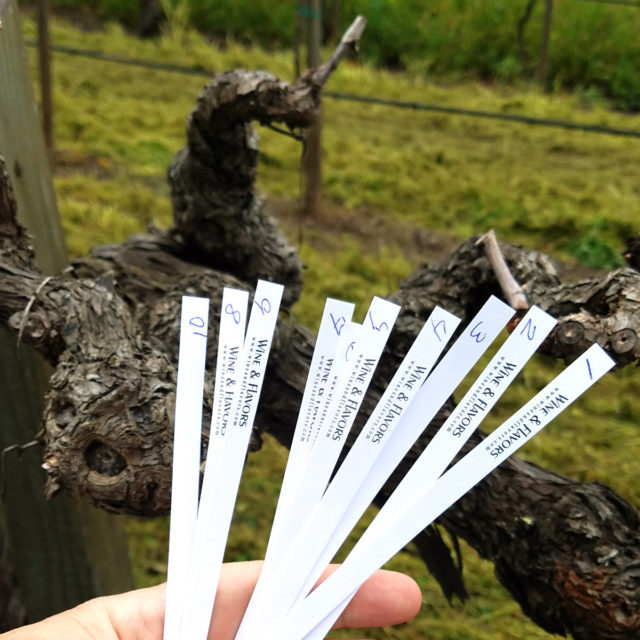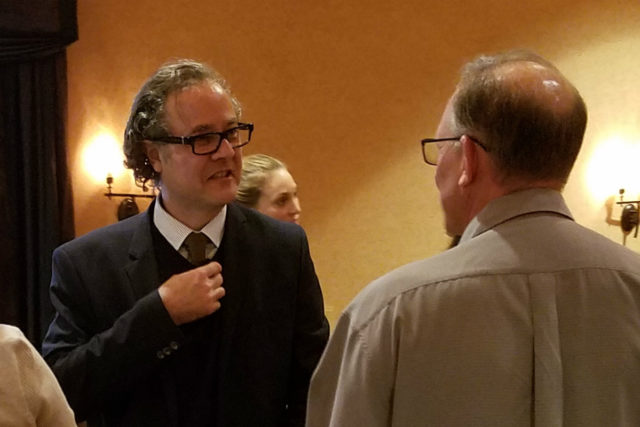By Dawn Dolan
Ninety or so people gathered at the Vintners Inn in Santa Rosa, CA on Wednesday, April 3rd to hear world–renown flavor expert Alexandre Schmitt speak on the topic of “Decoding Aroma Molecules in Wine & Cork” hosted by M.A. Silva USA. Introducing Monsieur Schmitt to the crowd was Neil Foster, president of M.A. Silva USA, which is based in Santa Rosa, CA. Foster discussed his company’s goal to, “Improve quality of natural wine corks, and invest in the best technology to improve the quality, continuously.” Yet, he introduced Schmitt, with the phrase that audience members were nodding their head to, “You can’t distill flavor perceptions through science.”

For this particular exercise, Schmitt’s focus was entitled, “Freshness in Wines, Distinction between Rising Freshness, Minty Notes, Aniseed Notes, the Concept of Licorice.” He began by leading the audience through a tutorial on how we categorize and recall scents; noting that our evolutionary development went from a basis in olfactory recognition to visual recognition. When man stood up sight became the best sense and protect modern hominids. Thus, our descriptors for olfactory input are limited, whereas we use, he said, one-third of our vocabulary to describe visual things.
In an interesting and related example, Schmitt said, “We only have about a dozen words to describe taste. We use other senses’ analogies to describe wine, like the word silky,” which is a word drawn from our tactile sense. In another example, the difference between pear and apple is often misused, as what we are really referring to is the texture; pear being grainier.
Quoting French philosopher of the 20th century, Jean-Paul Sartre, “To perceive is to judge,” Schmitt noted that all aspects of wine drinking affects our perception; the weight of the bottle, the label, the smells and quality of the cork—all these external cues create a preconceived notion of what we are about to taste. And sometimes our taste only corroborates this perception.
Schmitt lead the participants through a series of ten scents. “It’s always difficult to determine freshness in wine,” acknowledged Schmitt. “Flavors are related to our subjective perception.” We identify flavors based on our stored memories of having encountered them before. When we have not previously been exposed to a flavor or scent before, our brain searches for the nearest thing that we know.

Aroma sticks were handed out to each seminar participant, and Schmitt treated each of the ten as a mini-lesson in olfactory identification, asking for the audience’s perceptions at the start of each of the ten scent mini-lessons. His dry sense of humor gently mocked or praised the audience’s answers, keeping the feel lively without being too biting. “Your education is visual. You never received any olfactory education,” he excused them.
Describing them in detail once the audience’s guesses were all in, the scents he taught the crowd to distinguish included pine resin, camphor, menthol, eucalyptus, minty (spearmint), minty +menthol light (peppermint), laveo carron (a minty compound found in Cabernet Sauvignon), Fennel (Anise-like), anise +mint (caraway), and black licorice.
Schmitt also described the rising notes of freshness, with the most “cold” being menthol and pine, followed by eucalyptus and camphor. He admonished listeners to educate themselves on these smells, and cautioned that menthol is not a wine smell, and spearmint but never peppermint could be found in wines. Spearmint is a warming scent, by the way, and “rosemary” is a better herbal descriptor than “eucalyptus.”
A delightful foray into the world of highly nuanced elemental smelling, Schmitt took the audience through the fine detail of this corner of freshness in wines. Schmitt, is based in Bordeaux, France, where he conducts seminars through his company, Wine & Flavors, which is dedicated to olfactory education.


















